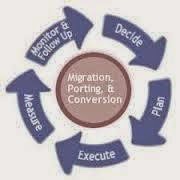Different
software products follow a different SDLC like Iterative Enhancement Model, Object
Oriented Methodology, and Dynamic System Development Method throughout software
product’s development. It is the responsibility of Business Analyst/Project
Manager to choose which SDLC would be beneficial so as to get better product in
given time span and in right budget. Following are the 5 rules that are
followed by BAPM for Software product sustenance:
Product
Development:
Software
Product Development is the methodology used for configuration, outlining, and leading
the process of developing and expanding products to satisfy end users needs. It
requires a lot of ground work so as to define the product perception, consider
product feasibility and ensure business achievement. A product advancement
initiative must guarantee quality and work towards a specific release date. A
Business Analyst/Project Manager understands the priorities and builds a
product roadmap so as to ensure that right product is built and within the
target budget and timeline.
Business
Analyst / Project Manager act as a sheet-anchor role and inspect the complete
project through the stages of SDLC to guarantee that the implementation process
is carried out uniformly and ends successfully. He also ensures that on
completion of the project, you get what you had actually wished for.
A
Business Analyst/Project Manager ensures that following services has been
delivered to the end user during development and after completion of the
software product:
- Guaranteed Return on Investment
- Faster development cycle
- Increased development productivity
- Low development costs
- Reduced time to market
- Quality software products are delivered
Performance Enhancement:
Evolving
technology necessitates the call for improvised solutions, enhanced products,
and superior features. Software Product needs to keep swiftness with such
dynamic changes offering new enhancements and features within a short
time-frame to sustain their position in competitive markets and retain their
customers. A BAPM plays a vital role when performance enhancement comes into
picture. He is responsible for the entire Product’s performance during and
after development. Enhancement may be in terms of speed, quality or Performance.
Porting
& Migration:
A BAPM helps to meet the software products unique integration and migration needs. Their knowledge and expertise in diverse technology platforms helps development team to perform integration and migration of software across complex platforms in heterogeneous environments.
Currently,
in software industry, incredible antagonism exists to gain the largest possible
consumer base. The majority of software companies have to build a product that
is offered to end users in all available platforms and to adapt new
technologies as soon as they are accessible.
Migration
and porting is a practical solution under these situations. This solution
requires the exact approach pooled with in-depth information of the latest
software technologies involved.
BAPM
provides an approach to porting and migration which does not focus solely on
converting the application to run in a new environment but it also ensures the
reliability and integrity of the application which is maintained throughout the
migration process.

Benefits
of porting and migration:
It
boosts visibility of the software product to new customers by offering services
in various platforms, also minimizes high costs of managing in-house team to execute
unnecessary and redundant functions, sustain a wider product portfolio by
re-allocating the capital to more complex and innovative tasks
Optimization:
Optimizing
software product is necessary for improving its performance, functionality, scalability
and flexibility to adapt to new technologies. Additionally, these optimizations
can help us to eliminate inefficiencies in the software product.
Maintenance
& Support:
As
the product matures and nears the closing stages of its lifecycle, there are
many synchronized actions that you will need for its maintenance and support. As
BAPM, they need to ensure that proper services are being provided to tackle those
exclusive needs during the after-sales stage of your software product. These
could be in terms of bug fixes, minor improvements and testing.
For
any software product, BAPM needs to ensure that proper product has been
delivered and it has been through different set of filters ensuring that almost
no bugs would occur when the products is delivered to the end user. He also
needs to ensure that the software product delivered to the end users have
fulfilled their current and near future requirements.
About Author:
Varun Shimoga is a consultant in Systems Plus Pvt. Ltd. Within Systems Plus, he actively contributes to the areas of Technology and Information Security. He can be contacted at: varun.shimoga@spluspl.com



Very informative best IT networking company in dubai
ReplyDeleteSoftware Product Development
ReplyDeleteI simply wanted to write down a quick word to say thanks to you for those wonderful tips and hints you are showing on this site.
ReplyDeleteFacility Management Software in USA
Software Product Development
ReplyDelete